The iPhone 5 Review
by Anand Lal Shimpi, Brian Klug & Vivek Gowri on October 16, 2012 11:33 AM EST- Posted in
- Smartphones
- Apple
- Mobile
- iPhone 5
General Purpose Performance
Section by Anand Shimpi
Apple's philosophy on increasing iPhone performance is sort of a mix between what Microsoft is doing with Windows Phone 7/8 and what the high-end Android smartphone makers have been doing. On the software side Apple does as much as possible to ensure its devices feel fast, although I notice a clear tendency for newer iOS releases to pretty much require the latest iPhone hardware in order to maintain that speedy feel over the long haul. When it comes to hardware, Apple behaves very much like a high-end Android smartphone vendor by putting the absolute fastest silicon on the market in each generation of iPhone. The main difference here is that Apple controls both the software stack and silicon, so it's able to deliver a fairly well bundled package each year. It's a costly operation to run, one that is enabled by Apple's very high profit margins. Ironically enough, if Apple's competitors would significantly undercut Apple (it doesn't cost $599 - $799 to build a modern smartphone) I don't know that the formula would be able to work for Apple in the long run (Apple needs high margins to pay for OS, software and silicon development, all of which are internalized by Apple and none of which burden most of its competitors).
Good cross platform benchmarks still don't really exist on smartphones these days. We're left describing experience with words and trying to quantify performance differences using web based benchmarks, neither of which is ideal but both of which will have to do for now. The iPhone 5 experience compared to the 4S is best explained as just being snappier. Apps launch faster, scrolling around iOS Maps is smoother, web pages take less time to load and the occasional CPU/ISP bound task (e.g. HDR image processing) is significantly quicker. If you're the type of person who appreciates improvements in response time, the iPhone 5 delivers.
How does it compare to the current crop of high-end Android smartphones? I would say that the 5 generally brings CPU performance up to par with the latest and greatest in the Android camp, and in some cases surprasses them slightly. It's difficult making cross platform comparisons because of huge differences in the OSes as well as separating out tasks that are CPU bound from those that simply benefit from a higher rendered frame rate.
I took a cross section of various web based benchmarks and looked at their performance to help quantify where the iPhone 5 stands in the world. First up are the RIABench focus tests, these are javascript benchmarks that focus on various compute bound tasks. I used Chrome for all Android devices to put their best foot forward.

This first test shows just how slow the 800MHz Cortex A9s in the iPhone 4S were compared to the latest and greatest from Qualcomm and NVIDIA. At roughly half the clock speed of those competitors, the 4S was just much slower at compute bound tasks. Apple was able to mask as much of that as possible with smooth UI rendering performance, but there was obviously room for improvement. The iPhone 5 delivers just that. It modernizes the iPhone's performance and inches ahead of the Tegra 3/Snapdragon S4 platforms. Only Intel's Atom Z2460 in the Motorola RAZR i is able to outperform it.
Next up is Kraken, a seriously heavy javascript benchmark built by Mozilla. Kraken focuses on forward looking applications that are potentially too slow to run in modern browsers today. The result is much longer run times than anything we've seen thus far, and a very CPU heavy benchmark:
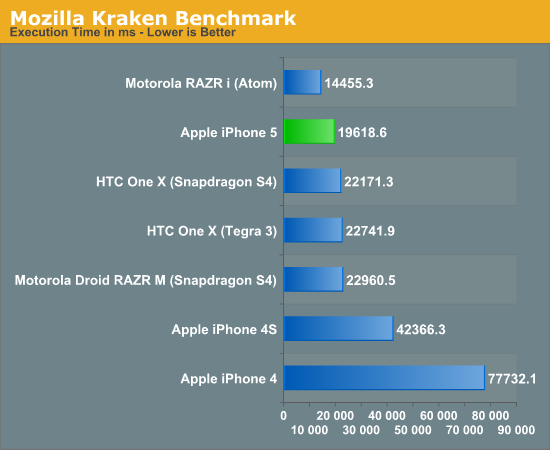
The standings don't change much here. The iPhone 4S is left in the dust by the iPhone 5, which steps ahead of the latest NVIDIA/Qualcomm based Android devices. The Apple advantage here is just over 10%. Once again, Intel's Atom Z2460 pulls ahead with the clear lead.
In our iPhone 5 Performance Preview we looked at Google's V8 javascript test as an alternative to SunSpider. The more data points the merrier:
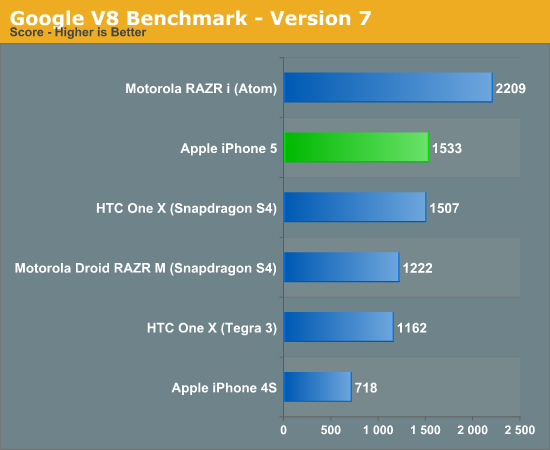
Here the iPhone 5 manages to hold onto its second place position, but just barely. Once more, the Atom based RAZR i maintains the performance lead.
Google's Octane benchmark includes all 8 of the V8 tests but adds 5 new ones including a PDF reader, 3D bullet physics engine and portable 3D game console emulator all built in javascript.
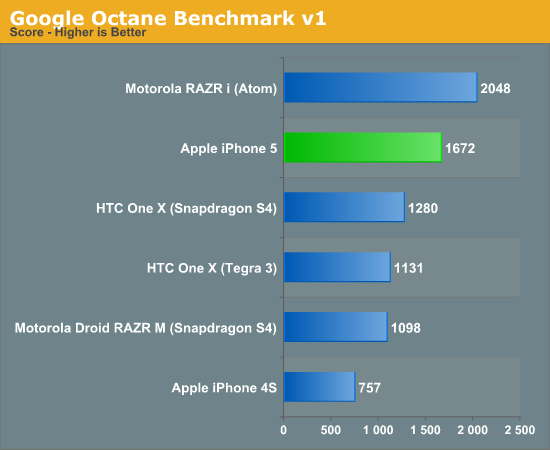
The 5 pulls ahead of the HTC One X here and maintains a healthy 31% lead, but once again falls short of the RAZR i.
We of course included our SunSpider and BrowserMark tests, both of which show the iPhone 5 very favorably:
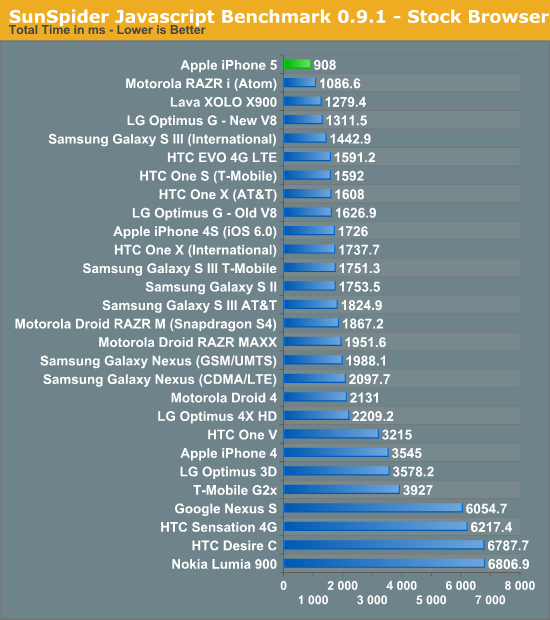
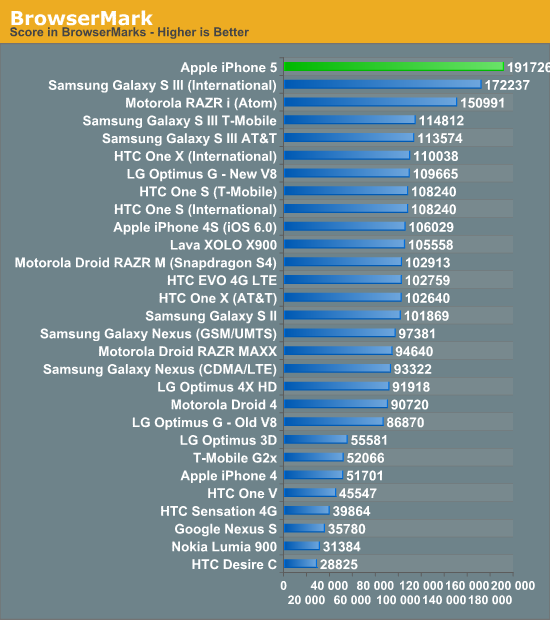
Performance obviously depends on workload, but it's clear the iPhone 5 is a big step forward from the 4S and tends to outperform the latest ARM based Android smartphones. As the rest of the ARM based SoC players move to Cortex A15 designs they should be able to deliver faster devices in the first half of 2013.
Intel's current position when it comes to CPU performance is interesting. A move to a dual-core design could be enough to remain performance competitive with 2013 ARM based SoCs. Remembering that Atom is a 5 year old CPU core that performs at the level of a 10 year old mainstream notebook CPU puts all of this progress in perspective. Intel's biggest issue going forward (other than getting Atom into more tier 1 phone designs) is going to be improving GPU performance. Luckily it seems as if it has the roadmap to do just that with the Atom Z2580.










276 Comments
View All Comments
rarson - Wednesday, October 17, 2012 - link
Car bumpers are not made of aluminum.Aluminum oxidizes. So if you scratch it, then you've removed that oxidation layer to allow it to further oxidize at that spot. Rust is just iron oxidation.
Spunjji - Friday, October 19, 2012 - link
It is not normal for them to scratch so damn easily. Furthermore, you might notice that other manufacturers (say, HTC?) take steps to harden the surfaces of their devices to avoid this kind of problem.name99 - Wednesday, October 17, 2012 - link
So you're basically(a) upset that Apple fans buy products based on how they look
(b) upset that Apple fans's don't care enough about how products look to care about this
???
The true sign of the demented mind --- that it can happily hold two contradictory opinions at once.
steven75 - Wednesday, October 17, 2012 - link
Would you buy a car that gets nicks and scratches from normal usage?Um yes, everyone does. I guess all cars should be recalled!
Spunjji - Friday, October 19, 2012 - link
Would you buy a car that gets nicks and scratches from simply driving down the street? No, you wouldn't. Stop distorting the argument for an easy victory, it makes for extremely aggravating reading.doobydoo - Saturday, October 20, 2012 - link
And what evidence do you have that the equivalent of 'driving down the street' with an iPhone causes scratching?ltcommanderdata - Tuesday, October 16, 2012 - link
Any final MHz rating on the GPU? Given Apple tends to use a 4:1 clock speed ratio between the CPU and GPU, the SGX543MP3 being up to 325MHz would make sense. The SGX543MP2 seemed to be clocked at 200MHz in the iPhone 4S and 250MHz in the iPad 2 and Apple said the iPad 2012 has a 2x faster GPU, so the SGX543MP4 in the A5X likely is also at 250MHz. A SGX543MP3 at 325MHz vs a SGX543MP4 at 250MHz would seem to explain the results seen in the benchmarks.A few corrections, on page 11 the GLBenchmark 2.5 - Triangle Texture Test - Fragment Lit (Offscreen 180p) is missing the iPad 2012 result.
In iPhone 5 Device Conclusions on page 22, you write "Going back to the old 4:3 aspect ratio iPhones feels extremely claustrophobic now", but it should be 3:2.
daar - Tuesday, October 16, 2012 - link
The in-depth tech info was nice, but would have preferred it in a second post. As an engineer, while I can appreciate the advances made with the new SoC and the depth of the effort went into researching all the aspects of the phone, I also think for most purposes, the length is counterproductive when the majority of readers are looking for indicators of whether the phone is worth an upgrade. Even without the tech explanation though, the review unnaturally lacked the concise detail I'm used to at AT.In some ways, it sort of came across that the tech explanation was a long worded way of making excuses for the iPhone 5's faults and direct comparisons to superior implementations were ignored. Simple example would be the camera, where praise was given about how they cut the size, that it looked good, explanation of the purple tint and so forth. If say, Samsung had released a phone with such issues, I'd expect the review to mention the sloppiness of it, esp with rivals such as the One X having a 2.0f lens (I quite enjoyed the One X/SG3 review comparison from AT). The excuse that the lack of innovation in the new iOS being that the aim of the phone is like that of an appliance whereas Android phones aiming to be PC's is baffling; the concept of a smartphone was a versatile device to aid in our daily lives not reach a point of some ambiguity called an appliance.
darwinosx - Tuesday, October 16, 2012 - link
That was a lot of words to say nothing besides bragging that you are an engineer. Nobody cares.kyuu - Tuesday, October 16, 2012 - link
What nobody cares about are your rabid attacks on any comment that has even the slightest critique of an Apple product.